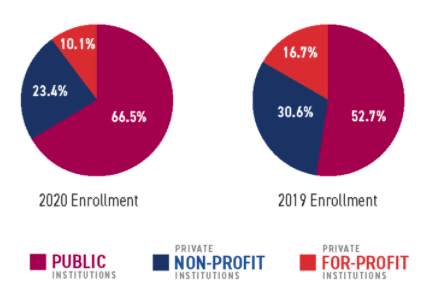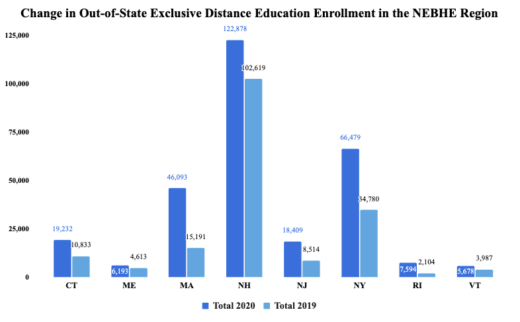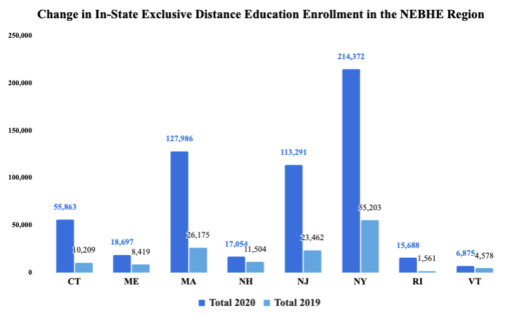 The number of students who sought postsecondary education through exclusively distance modalities grew from a little over 3 million in 2019 to more than 5.8 million in 2020, according to a new report by the National Council for State Authorization Reciprocity Agreements (NC-SARA).
The number of students who sought postsecondary education through exclusively distance modalities grew from a little over 3 million in 2019 to more than 5.8 million in 2020, according to a new report by the National Council for State Authorization Reciprocity Agreements (NC-SARA).
The “exclusively” qualifier refers to students who enrolled solely in programs via distance education, as distinct from “hybrid” students, many of whom returned to campus in 2020, but took some of their classes in person while taking others online.
NC-SARA and other stakeholders predicted that there would be some sort of increase in exclusively distance education enrollment due to the Covid-19 pandemic, but the near doubling of such enrollments was much more significant than anticipated.

Source: NC-SARA 2020 Data Report Executive Summary
NC-SARA’s Executive Summary, full report and downloadable data set are available on its website.
NC-SARA President and CEO Lori Williams noted that while the explosion in online education was catalyzed by the quick turn to remote and hybrid modalities, distance learning is likely here to stay: “In a lot of ways, NC-SARA’s latest data report and data set aligns with our expectations that distance education enrollment would skyrocket during the pandemic,” Williams said. “But we may also see from this report some signals regarding the ways higher education may continue to evolve and change in months and years after the Covid-19 pandemic. There are indicators in our data, and in other organizations’ research, of possible long-term modality shifts that may permanently alter the pursuit of postsecondary education.”
SARA—the State Authorization Reciprocity Agreement—provides a voluntary, regional approach to state authorization of postsecondary distance education. Institutions approved to participate in SARA benefit from a streamlined approach to securing approval to offer distance education and online programming in SARA member states. Participating institutions report enrollment data annually to NC-SARA, illustrating a more complete picture of student location and out-of-state learning activities nationally.
The NC-SARA data report breaks down the number of students enrolled in distance education by in-state enrollment and out-of-state enrollment as well as by sector and state. SARA allows for the interstate delivery of high quality distance education. Participating institutions in SARA states are therefore able to enroll students in online programs in not only the host states, but any other participating SARA state without the costly fees or regulatory headaches of traditional state authorization. This year’s data report reveals that 3.9 million students or 68% of all students enrolled in distance learning in state, compared with 1.8 million or 32% who enrolled in a distance learning programs out of state.
While in-state distance education more than doubled between 2019 and 2020, out-of-state distance education between 2019 and 2020 grew by only about 35%. One of the most compelling national findings is that in the fall of 2020, public institutions, which made up 50% of all reporting institutions, enrolled 85% of in-state distance learners. This indicates that public institutions are important actors in the implementation of distance education.

Source: NC-SARA 2020 Data Report Executive Summary
New England findings
NEBHE serves as the regional coordinating body in eight SARA states: the six New England states of Connecticut, Massachusetts, Maine, New Hampshire, Rhode Island and Vermont, as well as affiliate states New Jersey and New York. In this report cycle, 328 institutions located in the eight states reported 292,556 online students, making up 15% of the national SARA enrollments reported. Approximately 66% of those students enrolled in programs offered by an institution in their state of residence.
Consistent with the national trends, the institutions in the NEBHE states saw increases in both in-state and out-of-state distance enrollment. For the complete state by state breakdowns, refer to the charts below.
In the fall of 2020, 266,842 students who lived in SARA participating states outside Connecticut, Maine, Massachusetts, New Hampshire, New Jersey, New York, Rhode Island or Vermont, were enrolled in distance education in the aforementioned NEBHE-SARA states. In the same year, 25,714 students were enrolled in distance education in New England who hailed from non-SARA participating states or territories (California is the last remaining state that is not a member of the agreement).
In fall 2020, 569,826 students who lived in SARA participating states within the NEBHE region enrolled in exclusively distance education in their state of residence. The total number of both in-state and out-of-state students enrolled in distance education in New England, New Jersey and New York in the fall of 2020 was 862,382.

* The large representation of New Hampshire students compared with their overall state population is in part because of Southern New Hampshire University (SNHU), a primarily online institution, which enrolls 132,000 online students

See NC-SARA’s Data Dashboards here
For more information on state, regional and national findings, check out the full report here.
Sheridan Miller is state policy engagement specialist at NEBHE. If you would like more information about NEBHE’s SARA program, click here.
[ssba]
